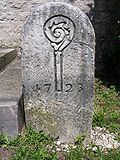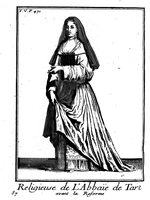
Tart Abbey
Encyclopedia

Tart-l'Abbaye
Tart-l'Abbaye is a commune in the Côte-d'Or department in eastern France.-Population:-References:*...
in Burgundy (Côte-d'Or
Côte-d'Or
Côte-d'Or is a department in the eastern part of France.- History :Côte-d'Or is one of the original 83 departments created during the French Revolution on 4 March 1790. It was formed from part of the former province of Burgundy.- Geography :...
), near Genlis
Genlis
Genlis is a commune in the Côte-d'Or department in eastern France.-Population:-References:*...
, on the banks of the River Ouche
Ouche
The Ouche is a river in the Côte-d'Or department in eastern France. It is a right tributary of the Saône, which it joins in Échenon. Its source is in Lusigny-sur-Ouche. The Ouche flows through the following towns: Bligny-sur-Ouche, La Bussière-sur-Ouche, Fleurey-sur-Ouche, Velars-sur-Ouche, Dijon,...
and only a few miles away from Cîteaux Abbey
Cîteaux Abbey
Cîteaux Abbey is a Roman Catholic abbey located in Saint-Nicolas-lès-Cîteaux, south of Dijon, France. Today it belongs to the Trappists, or Cistercians of the Strict Observance . The Cistercian order takes its name from this mother house of Cîteaux, earlier Cisteaux, near Nuits-Saint-Georges...
, the Cistercian mother house. The community moved to Dijon
Dijon
Dijon is a city in eastern France, the capital of the Côte-d'Or département and of the Burgundy region.Dijon is the historical capital of the region of Burgundy. Population : 151,576 within the city limits; 250,516 for the greater Dijon area....
in 1623, and the abbey buildings in Tart were destroyed by war shortly afterwards; only ruins remain.
Foundation and first century
The foundation charter of Tart Abbey is dated 1132, although the deed mentions three previous gifts from 1125. The founder was Arnoul Cornu, lord of Tart-le-HautTart-le-Haut
Tart-le-Haut is a commune in the Côte-d'Or department in eastern France.-Population:-References:*...
, and his wife Emeline, and their gift consisted of the land of Tart, the tithes of Rouvres
Rouvres-en-Plaine
Rouvres-en-Plaine is a commune in the Côte-d'Or department in eastern France.-Population:-References:*...
and Tart-la-Ville and the grange of Marmot.
It seems clear that the creation of this community was the result of a lengthy series of transactions, which may have begun in about 1120, involving not only Arnoul but the lord of Vergy (his overlord); Josserand de Brancion, Bishop of Langres; the family of Hugh II, Duke of Burgundy
Hugh II, Duke of Burgundy
Hugh II of Burgundy was duke of Burgundy between 1103 and 1143. Hugh was son of Odo I, Duke of Burgundy.-Marriage and issue:He married, in about 1115, Felicia-Matilda of Mayenne, daughter of...
; the cathedral chapter of Langres; and Stephen Harding
Stephen Harding
Saint Stephen Harding is a Christian saint and abbot, one of the founders of the Cistercian Order.-Life:Stephen Harding was born in Dorset, England. He was placed in Sherborne Abbey at a young age, but eventually put aside the cowl and became a travelling scholar. He eventually moved to Molesme...
, abbot of the nearby Cîteaux Abbey.
The first abbess was Elizabeth de Vergy, widow of Humbert de Mailly, lord of Faverney or Fauverney
Fauverney
Fauverney is a commune in the Côte-d'Or department in eastern France.-Population:-References:*...
, daughter of Savary de Donzy, Count of Chalon-sur-Saône. She was previously a novice in a Benedictine nunnery, Jully Abbey or Priory, at Jully-les-Nonnains, from where the new foundation at Tart was settled. She remained its head for the next 40 years.
Pope Eugene III
Pope Eugene III
Pope Blessed Eugene III , born Bernardo da Pisa, was Pope from 1145 to 1153. He was the first Cistercian to become Pope.-Early life:...
put the abbey under Papal protection by a bull
Papal bull
A Papal bull is a particular type of letters patent or charter issued by a Pope of the Catholic Church. It is named after the bulla that was appended to the end in order to authenticate it....
of 1147, confirmed by his successors.

Beaune
Beaune is the wine capital of Burgundy in the Cote d'Or department in eastern France. It is located between Paris and Geneva.Beaune is one of the key wine centers in France and the annual wine auction of the Hospices de Beaune is the primary wine auction in France...
, Chambolle-Musigny
Chambolle-Musigny
Chambolle-Musigny is a commune in the Côte-d'Or department in eastern France.It is one of the wine villages situated on the Côte-d'Or escarpment, and is one of the twelve Cote d'Or communes of France which added/adopted the name of their most well-known vineyard as a suffix to the original name of...
, Morey-Saint-Denis
Morey-Saint-Denis
Morey-Saint-Denis is a commune in the Côte-d'Or department in eastern France.-Population:-Wine:Morey-Saint-Denis is situated in the Northern section of the Côte d'Or called Côte de Nuits. It is one of the principal wine producing villages of the region....
, Chézeaux and Vosne-Romanée
Vosne-Romanée
Vosne-Romanée is a commune in the Côte-d'Or department in Burgundy in eastern France.-Population:-Wine:It produces the region's most celebrated wines, all made entirely from the Pinot Noir grape: "There can be little doubt that in the firmament of the Cote de nuits, Vosne-Romanée is the brightest...
. Physical labour in the fields and vineyards was regarded as too strenuous for female religious, and the work was undertaken by lay brothers from Cîteaux. These were often in short supply, and the nuns were obliged to hire day-labourers to make up the shortfall.
The abbot of Cîteaux also oversaw the spiritual discipline of the nunnery and was responsible for the appointment of the abbess, who was not elected by the community, as was the practice elsewhere. Tart soon became the head of the female branch of the Cistercians, and was directly responsible for the foundation of many further nunneries in France
and more in Spain.
By the end of the 13th century, when the supply of gifts was drying up, the abbey had amassed sufficient wealth, mostly in the form of land, and gained sufficient ability to manage it, to secure their future through the hardships to come, of which there were many: the Hundred Years' War
Hundred Years' War
The Hundred Years' War was a series of separate wars waged from 1337 to 1453 by the House of Valois and the House of Plantagenet, also known as the House of Anjou, for the French throne, which had become vacant upon the extinction of the senior Capetian line of French kings...
, the Grandes Compagnies and the Écorcheurs, and the epidemics and calamities that these brought with them, lasted more or less right up to the start of the French Wars of Religion
French Wars of Religion
The French Wars of Religion is the name given to a period of civil infighting and military operations, primarily fought between French Catholics and Protestants . The conflict involved the factional disputes between the aristocratic houses of France, such as the House of Bourbon and House of Guise...
.
Decadence and reform

In 1617, however, Jeanne-Françoise de Courcelles de Pourlan (b. 1591), who had been educated as a girl at Tart, returned as abbess, with a strong determination to bring about the required reform. Despite the great resistance of the rest of the community, she found a powerful ally in Sébastien Zamet, Bishop of Langres. Opposition to the reform, inside and outside the nunnery, was so great that there was an attempt on the bishop's life. Eventually they decided that reform was impossible as long as the community remained in the abbey at Tart, and that the only way to bring it about was to transfer the nunnery into Dijon
Dijon
Dijon is a city in eastern France, the capital of the Côte-d'Or département and of the Burgundy region.Dijon is the historical capital of the region of Burgundy. Population : 151,576 within the city limits; 250,516 for the greater Dijon area....
, on the basis that in a town it was far easier to maintain seclusion and the discipline of the spiritual life.
Accordingly, those of the community who were willing to accept the new and stricter life - five, plus two novices - moved to Dijon on 24 May 1623.
Dijon

Matthias Gallas
Matthias Gallas, Graf von Campo und Herzog von Lucera , was an Austrian soldier, who first saw service in Flanders, then in Savoy with the Spaniards, and subsequently joined the forces of the Catholic League as captain during the Thirty Years' War.On the general outbreak of hostilities in Germany,...
sacked and burnt the abbey buildings at Tart in the course of the Thirty Years' War
Thirty Years' War
The Thirty Years' War was fought primarily in what is now Germany, and at various points involved most countries in Europe. It was one of the most destructive conflicts in European history....
, except for an isolated chapel.
After the election of an opponent of the reform, Pierre Nivelle, as abbot of Cîteaux, Jeanne de Pourlan (who had taken the religious name of Jeanne de Saint Joseph) put herself under the jurisdiction of the Bishop of Langres. At the same time she changed the previous system, whereby the abbot of Cîteaux had directly nominated the abbess, to a three-yearly election by the nuns.
The community was dissolved during the French Revolution
French Revolution
The French Revolution , sometimes distinguished as the 'Great French Revolution' , was a period of radical social and political upheaval in France and Europe. The absolute monarchy that had ruled France for centuries collapsed in three years...
. The buildings after passing through a number of uses are now a museum of Burgundian life, the Musée Perrin de Puycousin, and the former church is now the Dijon Museum of Sacred Art (Musée d'art sacré de Dijon).
External links
- « Études d’histoire et d’archéologie cisterciennes », Benoît Chauvin, Bulletin du Centre d'études médiévales d'Auxerre, 10 (2006)
- Claude Chapuis, Cahiers du CEREN 13 (2005), Le Clos de Tart, Le Patrimoine viticole des Dames de Tart, 2005

